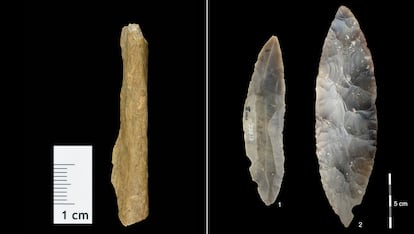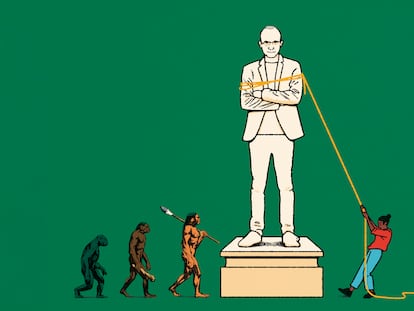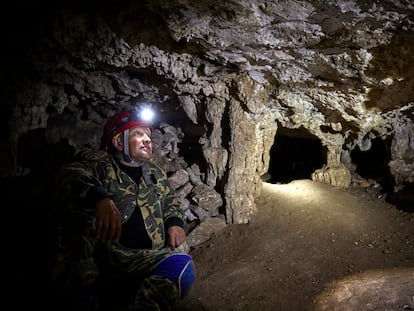The discovery of early human remains north of the Alps raises new questions about the relationship between ‘Homo sapiens’ and Neanderthals
Researchers have sequenced prehistoric DNA to solve the mystery of who created the 47,000-year-old arrows found in the heart of Europe

47,000 years ago, in the heart of Europe, halfway between today’s Frankfurt and Berlin, the climate was frigid, similar to the one found in Siberia today. But these conditions did not scare off the pioneers of the region’s first human colonization. Between 1932 and 1938, thousands of fossils of many animal species — some of which are difficult to identify — were found in the Ilsenhöhle cave in Ranis, Germany, along with leaf-shaped tools, possibly used for hunting, known as the LRJ (Lincombian-Ranisian-Jerzmanowician) industry. Found in Poland, Germany and the United Kingdom, these objects used to be associated with the last Neanderthals, the hominid species that inhabited Europe for tens of thousands of years before the arrival of Homo sapiens. But a paper published today in the journal Nature, along with two others in Nature Ecology & Evolution, may change that interpretation of history.
In 2016, an international team of scientists led by Jean-Jacques Hublin of the Max Planck Institute for Evolutionary Anthropology in Leipzig, Germany, returned to the Ilsenhöle cave to complete the information collected in the 1930s and try to identify who created the LRJ tools. With new techniques for dating remains, identifying ancient DNA and reconstructing the climatic conditions and diet of the cave visitors, they were able to associate modern humans with a technology previously attributed to Neanderthals for the first time. In so doing, scientists also confirmed their presence in an area so far north, where it was freezing almost all year round, at such an early time.
“In the end, it seems that LRJ has nothing to do with Neanderthals. It is one of the European forms of the Upper Paleolithic [the period when modern humans replaced the diversity of species of human lineage present up to that time] that appeared in the Middle East, where it was produced by the Homo sapiens coming out of Africa,” says Hublin.
The new results are one more piece of information in a long process of reconstructing ancestral human migrations from Africa. There were already remains of Homo sapiens from 50,000 years ago in Bulgaria and even evidence from 54,000 years ago in southeastern France. In the Ilsenhöle cave, the possibility of recovering DNA from the Pleistocene through a technology developed by Svante Pääbo, the 2022 winner of the Nobel Prize in Medicine, made it possible to identify the remains found in the 2016 campaign as human; it also enabled doing the same with some of the remains recovered in the 1930s.

Fossils of animals well adapted to the cold — such as hyenas that used it as a refuge and cave bears that hibernated there — were discovered in that shelter. There are also bones from woolly rhinoceroses and reindeer, which sometimes served as food for the small human groups that ventured that far north.
Sarah Pederzani, a researcher at the University of La Laguna and author of the paleoclimatic study in Nature Ecology & Evolution, notes that “until recently, it was thought that resistance to such cold climatic conditions did not appear until several thousand years later, so it is a surprising result.” One of the possible explanations behind the effort to adapt to such an extreme climate are the herds of large animals that could be found in that central European steppe. According to Hublin, these results show that, because “these groups of pioneers were already capable of facing such a harsh environment” and “had more flexibility than the Neanderthals to adapt,” the small groups that arrived there took advantage of the ability to settle in the northern periphery of other species’ domains and live off the available game.
The association of the LRJ technology with our species and the date of arrival in northern Europe raises questions about the relationship between Homo sapiens and Neanderthals. On the one hand, it would have been possible that the stone blades, perhaps used in hunting, were developed by the new immigrant species and then adapted by the autochthonous Neanderthals, or even that the exchange of knowledge had occurred in the other direction. Although it seems likely that the newcomers are partly to blame for the disappearance of those other humans, there is evidence that they had children together and, at least in some cases, imitated the other species’ cultural products. In the case of the Ilsenhöhle remains, the authors believe that, despite what had previously been thought, the carved blades were a Homo sapiens invention: “There are technological similarities with other Homo sapiens technologies,” but “as of now we do not have evidence that the Neanderthals learned [LRJ],” Weiss notes.
Regarding the H. sapiens’ influence on the Neanderthal downfall, Weiss is cautious: “At the moment, we can only say that there were populations of Homo sapiens in northern Europe when Neanderthals were living in the southwest. For now, we can’t say whether they met or interacted.” Hublin adds that “it took a long time for Neanderthals to be replaced further south, in France and Spain.” That, he concludes, only happened with the next human wave. The new arrivals came less than 40,000 years ago and are associated with Aurignacian technology, which erased the genetic imprint of the Homo sapiens who adapted to the cold and replaced the Mousterian, a method of making tools that had served Neanderthals for the previous 800 centuries.
Sign up for our weekly newsletter to get more English-language news coverage from EL PAÍS USA Edition
Tu suscripción se está usando en otro dispositivo
¿Quieres añadir otro usuario a tu suscripción?
Si continúas leyendo en este dispositivo, no se podrá leer en el otro.
FlechaTu suscripción se está usando en otro dispositivo y solo puedes acceder a EL PAÍS desde un dispositivo a la vez.
Si quieres compartir tu cuenta, cambia tu suscripción a la modalidad Premium, así podrás añadir otro usuario. Cada uno accederá con su propia cuenta de email, lo que os permitirá personalizar vuestra experiencia en EL PAÍS.
¿Tienes una suscripción de empresa? Accede aquí para contratar más cuentas.
En el caso de no saber quién está usando tu cuenta, te recomendamos cambiar tu contraseña aquí.
Si decides continuar compartiendo tu cuenta, este mensaje se mostrará en tu dispositivo y en el de la otra persona que está usando tu cuenta de forma indefinida, afectando a tu experiencia de lectura. Puedes consultar aquí los términos y condiciones de la suscripción digital.
More information
Últimas noticias
Most viewed
- Sinaloa Cartel war is taking its toll on Los Chapitos
- Oona Chaplin: ‘I told James Cameron that I was living in a treehouse and starting a permaculture project with a friend’
- Reinhard Genzel, Nobel laureate in physics: ‘One-minute videos will never give you the truth’
- Why the price of coffee has skyrocketed: from Brazilian plantations to specialty coffee houses
- Silver prices are going crazy: This is what’s fueling the rally











































